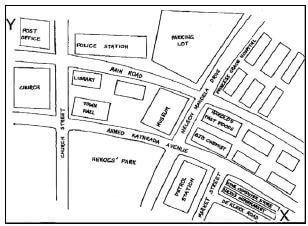SHORTER TRANSACTIONAL TEXTS GRADE 12 NOTES - LITERATURE STUDY GUIDE
Share via Whatsapp Join our WhatsApp Group Join our Telegram Group- Steps to writing shorter transactional texts in the exams
- Category A
- Advertisement
- Invitation card
- Flyer
- Poster
- Category B
- Diary entry
- Postcard
- Category C
- Instructions
- Directions
- What is expected from you in the exam?
Section C: Shorter transactional texts
This type of transactional text is a short written exchange of information, or a written record of communication. Each type of writing has a specific purpose and format, such as conducting business, or sharing news.
In this section, you will learn the features of each type of shorter transactional text that will earn you marks in the final Grade 12 exam. There are three categories of shorter transactional text as shown above.
The exam will contain one question from each of the three categories listed here.
You will only have to answer ONE of the questions.
1. Steps for writing shorter transactional texts
There are four steps involved in writing a shorter transactional text in an exam:
- Step 1: Choose your text type
- Step 2: Plan your topic
- Step 3: Write a draft of your text and edit it
- Step 4: Write your final text
Step 1: Choose your text type and topic
There are three categories of shorter transactional texts. The exam has one question for each of these three categories. You only have to answer ONE of the questions. Choose the text type format you know best.
The three categories of shorter transactional texts | |
1. Category A |
|
2. Category B |
|
3. Category C |
|
Hint
|
Step 2: Plan your topic
Remind yourself of the correct format for the text type you have chosen.
Plan your text by writing down your ideas for the content. Remember that your ideas must be relevant to the topic and the text type you have chosen.
There are many different ways to plan your text. For example, you could use a mind map. Use the planning method that works best for you. There are examples of planning tools on page 121.
Once you have written down a few ideas, you can organise them by numbering them in a logical order. This is the order in which your ideas will appear in your text.
Hint:
|
Ways to plan shorter transactional text
A plan helps you think about what ideas you want to include in your text. It also helps you put your ideas into a clear structure. You will earn marks for showing your planning.
You can use a mind map or an ideas list to plan your text.
1. Mind maps
These are diagrams of ideas. The title is in the centre with branches coming from it showing thoughts and ideas. Below is an example of a mind map.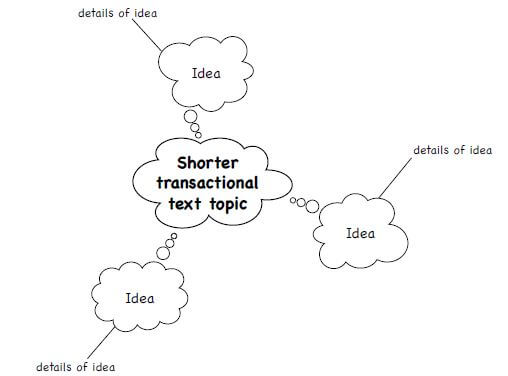
2. Idea lists
These help you to quickly write down ideas for each paragraph. Write down your ideas as they come to you and then organise them ideas in a logical order. Below is an example.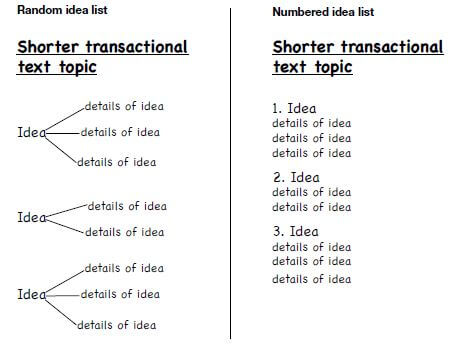
Step 3: Write and edit your draft text
Write a draft of your text, using the ideas from your plan.
Check that the format is right for the text type you have chosen.
Read through each sentence carefully to proofread it. Look for any spelling, punctuation or other language mistakes. Edit your draft by correcting these mistakes and making any other changes you think are needed. This will improve your final text.
Count the number of words in your text and make any changes to meet the word limit. For example, you may need to add some words or use fewer words.
Hint:
|
Step 4: Write your final text
Write your final text by rewriting your draft. Make sure that you make all the changes you marked in your draft so that your final text is error-free and clearly expresses all your best ideas. Check again that the text is in the correct format for the text type.
When you have finished your final text, cross out your planning and draft text. If you do not do this, the examiner may mark your draft and not your final text.
Hint:
|
Important differences between formal and informal writing
Formal writing | Informal writing |
|
|
|
|
|
|
|
|
|
2. Category A
Category A in the exam paper covers the following texts:
- Advertisement
- Invitation card
- Flyer
- Poster
2.1 Writing an advertisement
Advertisements aim to sell products or services. They are found in electronic media, such as on TV, radio and websites; in the cinema; and through sms’s to cellphones.
They are also found in print media. Printed adverts can take the form of flyers, posters and billboards; catalogues and advertising supplements; and adverts placed in newspapers and magazines.
Hint:
|
eg: A learner's example of an advertisement using the four steps
Step 1: Choose the text type
This learner chose this question on an advertisement:
Your family runs a home business making products such as toys, ethnic jewellery and clothing. Write out the advertisement to promote the sale of ONE of the products to tourists.
You should include the following in your advertisement: a brand name, a slogan, details of the product and where to find it.
Note: Do not include illustrations.
Step 2: Plan the text
Read the question carefully. Identify the key words to use in your planning.
In this topic, the key words are business, toys, tourists, brand name, slogan and details of product.
This learner used a mind map to plan his advertisement: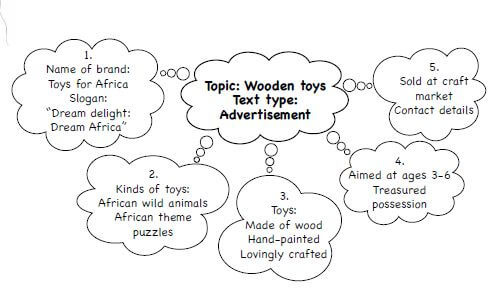
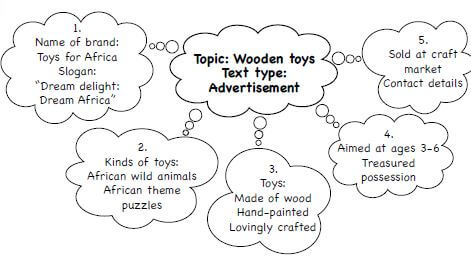

 Step 3: Write and edit the draft text
Step 3: Write and edit the draft text
Write a draft of the text using the ideas from the plan. Edit the draft by correcting any grammar, punctuation, spelling and format errors.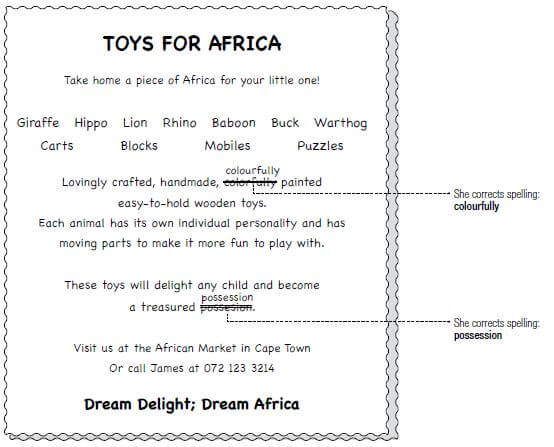
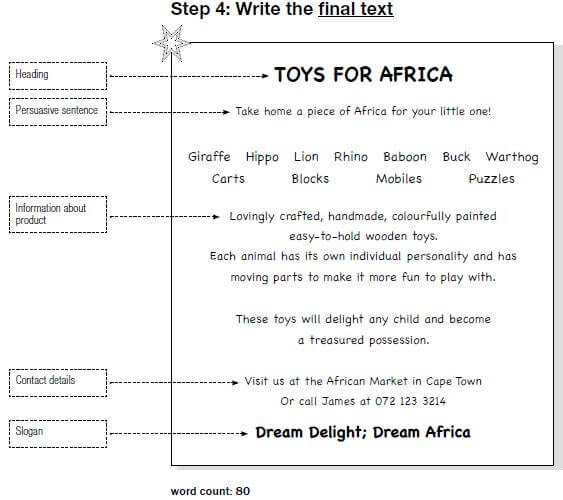
Activity: Writing an advertisement
Here are some topics to help you to practise writing advertisements:
- Your neighbour is a businessman who has developed a new hair care product. He wishes to advertise the product in a national magazine. He has asked you to write the advertisement.
Write this advertisement.
Note: Do not include illustrations. - You help your family run a small family business, but sales have recently decreased. Your father has asked you to write an advertisement that will promote the business.
2.2 Advertisement checklist
Features | Details of the feature | Yes | No | Don't know |
Text type | I understand the features of an advertisement. | |||
Topic | I understand the topic I have chosen. | |||
Content, planning and format | ||||
Planning | I can show evidence of planning. | |||
Content | Each point in plan is relevant to my topic. | |||
Purpose / Audience | I understand the purpose of an advertisement. | |||
Format | My layout is eye catching and makes the information easy to understand. | |||
Language, style and editing | ||||
Choice of words / diction | I have chosen my words carefully to make my text interesting. | |||
Language | I have checked and corrected my grammar, spelling and punctuation. | |||
2.3 Writing an invitation card
An invitation card is a written request inviting someone to attend a specific occasion.
Hint:
|
Eg: A learner’s example of an invitation card using the four steps
Step 1: Choose the text type and topic
This learner chose this question on an invitation card:
You have been asked to invite guests to your school’s prize-giving function. A former principal of the school will be the guest speaker.
Write out the invitation card you will send to the guests.
Note: Do not include illustrations or drawings.
Step 2: Plan the text
Read the question carefully. Identify the key words to use in your planning. In this topic, the key words are school’s prize-giving function, former principal, guest speaker and invitation card to guests.
This learner used a list to plan her invitation card.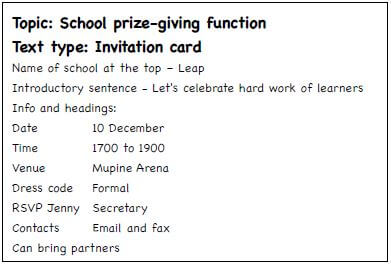
Step 3: Write and edit the draft text
Write a draft of the text using the ideas from the plan. Edit the draft by correcting any grammar, punctuation, spelling and format errors.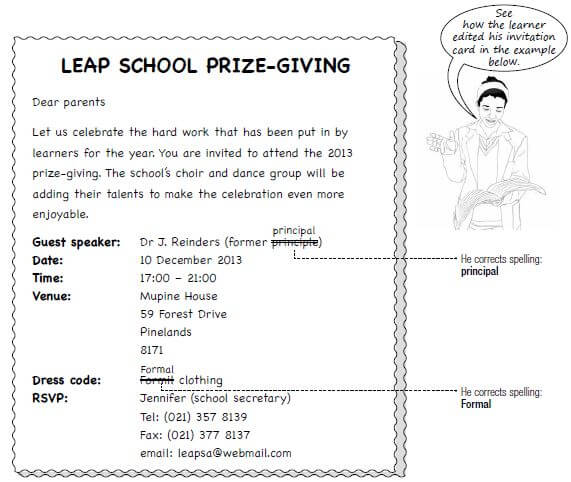
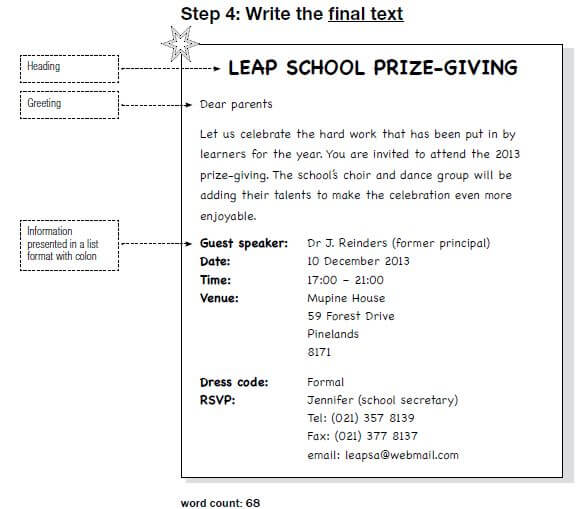
Activity: Writing an invitation card
Here are some topics to help you to practise writing invitation cards:
- The couple living next door to you has been married for 50 years. They are planning to celebrate this by hosting a formal function. You have been asked to prepare the formal invitation.
Write the invitation that will be sent to their families and friends.
Note: Do NOT include illustrations. - Your school’s Life Orientation teacher has invited a well-known personality to give a motivational talk to the learners at your school. As chairperson of your school’s Learners’ Representative Council, you wish to invite the chairpersons of the Learners’ Representative Councils of neighboring schools.
Write the invitation you will send to them.
2.4 Invitation card checklist
Features | Details of the feature | Yes | No | Don't know |
Text type | I understand the features of an invitation card. | |||
Topic | I understand the topic I have chosen. | |||
Content, planning and format | ||||
Planning | I can show evidence of planning. | |||
Content | Each point in plan is relevant to my topic. | |||
Purpose / Audience | I understand the purpose of an invitation card. | |||
Format | My invitation card has a clear heading and the details of the event are listed below using colons. | |||
Language, style and editing | ||||
Choice of words / diction | I have chosen my words carefully to make my text interesting. | |||
Language | I have checked and corrected my grammar, spelling and punctuation. | |||
2.5 Writing a flyer
A flyer is a cheap and simple form of advertising. It is usually a one-page leaflet that is handed out to people.
Hint:
|
eg: A learner’s example of a flyer using the four steps
Step 1: Choose the text type and topic
This learner chose this question on a flyer:
You employed a painter, Isaac Khumalo, to paint your house. His work was of a high standard. He now wishes to promote his business and has asked you to write a flyer.
Write out this flyer.
Note: Do not include illustrations or drawings.
Step 2: Plan the text
Read the question carefully. Identify the key words to use in your planning. In this topic, the key words are painter, high standard, promote and flyer.
The learner has used a mind map to plan her flyer.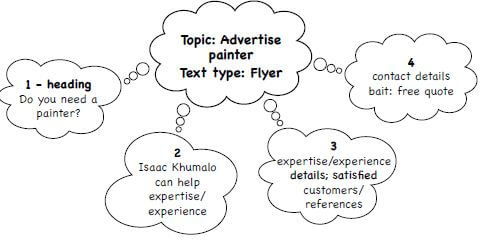
Step 3: Write and edit the draft text
Write a draft of the text using the ideas from the plan. Edit the draft by correcting any grammar, punctuation, spelling and format errors.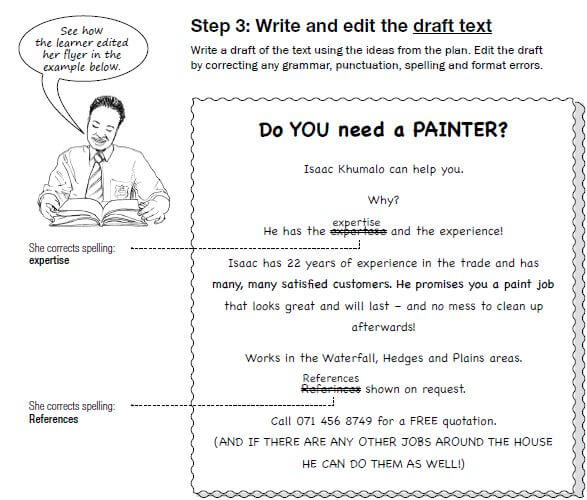
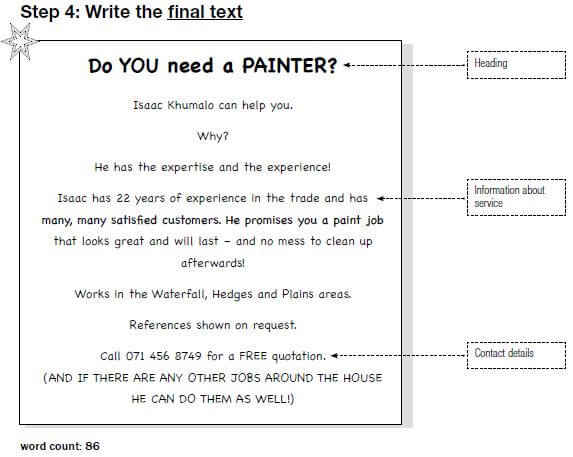
Activity: Writing a flyer
Here are some topics to help you to practise writing flyers:
- You live next door to the Public Relations Officer for your town/ city/suburb. He/she is organising a flea market to raise funds to beautify the town/city/suburb. Write this flyer.
- You are a Grade 12 learner who is excellent at Maths. You wish to earn some pocket money by offering extra lessons. Write a flyer in which you advertise your services.
- Your uncle has a small gardening service. However, he needs more customers and he has asked you for help. Write a flyer in which you promote his business.
2.6 Flyer checklist
Features | Details of the feature | Yes | No | Don't know |
Text type | I understand the features of a flyer. | |||
Topic | I understand the topic I have chosen. | |||
Content, planning and format | ||||
Planning | I can show evidence of planning. | |||
Content | Each point in plan is relevant to my topic. | |||
Purpose / Audience | I understand the purpose of a flyer. | |||
Format | My flyer has a clear heading. | |||
Language, style and editing | ||||
Choice of words / diction | I have chosen my words carefully to make my text interesting. | |||
Language | I have checked and corrected my grammar, spelling and punctuation. | |||
2.7 Writing a poster
A poster is a large printed notice in a public place. It is a simple form of advertising that uses bold lettering and an interesting layout to catch people’s attention.
Hint:
|
eg: A learner’s example of a poster using the four steps
Step 1: Choose the text type and topic
This learner chose this question on a poster:
Your friends have formed a band and have been offered the opportunity to play at a local restaurant.
Write the poster that promotes their appearance at this venue.
Note: No drawings or illustrations are required.
Step 2: Plan the text
Read the question carefully. Identify the key words to use in your planning. In this topic, the key words are band, local restaurant and poster.
The learner has used a mind map to plan his poster.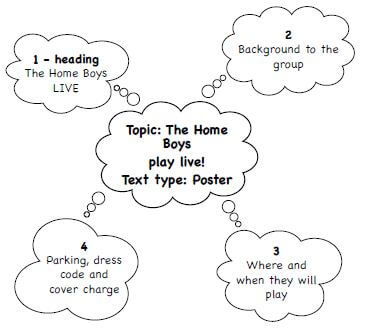
Step 3: Write and edit the draft text
Write a draft of the text using the ideas from the plan. Edit the draft by correcting any grammar, punctuation, spelling and format errors.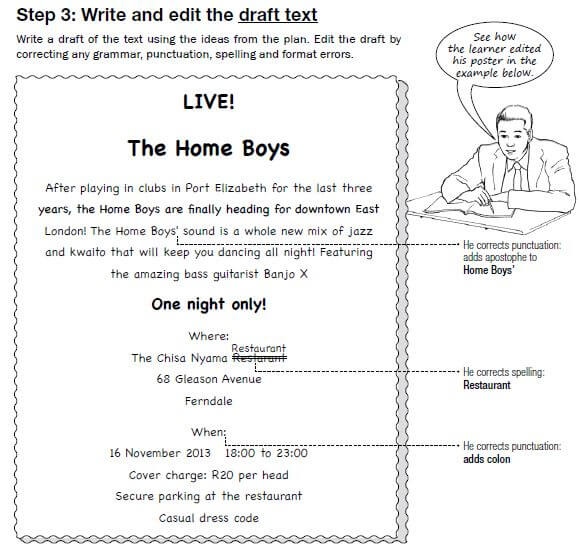
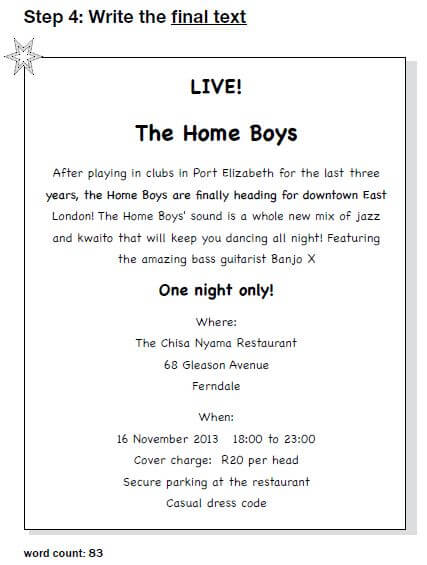
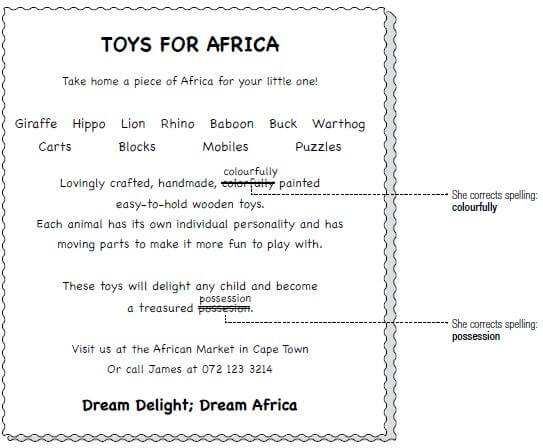
Activity: Writing a poster
Here are some topics to help you to practise writing posters:
- You live next door to the local councillor for your ward/suburb. He/she is organising a flea market to raise funds to beautify the suburb. Write out this poster.
Note: No illustrations are required. - Road deaths are a continual source of worry for traffic authorities. The campaign that they have come up with to make motorists obey the rules of the road and drive safely is called Arrive Alive.
Write out a poster for Arrive Alive.
Note: No illustrations are required.
2.8 Poster checklist
Features | Details of the feature | Yes | No | Don't know |
Text type | I understand the features of a poster. | |||
Topic | I understand the topic I have chosen. | |||
Content, planning and format | ||||
Planning | I can show evidence of planning. | |||
Content | Each point in plan is relevant to my topic. | |||
Purpose / Audience | I understand the purpose of a poster. | |||
Format | I have used a bold heading and laid out the information in a clear and eye-catching way. | |||
Language, style and editing | ||||
Choice of words / diction | I have chosen my words carefully to make my text interesting. | |||
Language | I have checked and corrected my grammar, spelling and punctuation. | |||
3. Category B
Category B in the exam paper covers the following texts:
- Diary entry
- Postcard
3.1 Writing a diary entry
A diary entry is a personal account of events, thoughts and feelings that the writer has experienced.
Hint:
|
Eg: A learner’s example of a diary entry using the four steps
Step 1: Choose the text type and topic
This learner chose this question on a diary entry:
You are in Grade 12 and you have been experiencing mixed feelings about the final examinations.
Write down your diary entries for the following TWO days:
- The day before the examination starts
- The last day of the examination
Step 2: Plan the text
Read the question carefully. Identify the key words to use in your planning. In this topic, the key words are mixed feelings, final examinations, day before, last day of the examination and diary entries.
The learner has used a mind map to plan her diary entries.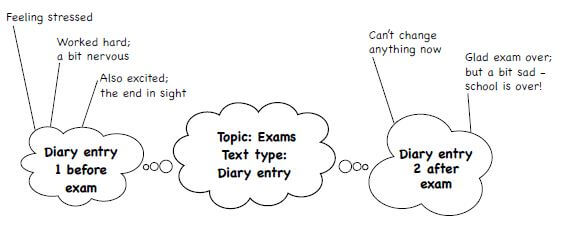
Step 3: Write and edit the draft text
Write a draft of the text using the ideas from the plan. Edit the draft by correcting any grammar, punctuation, spelling and format errors.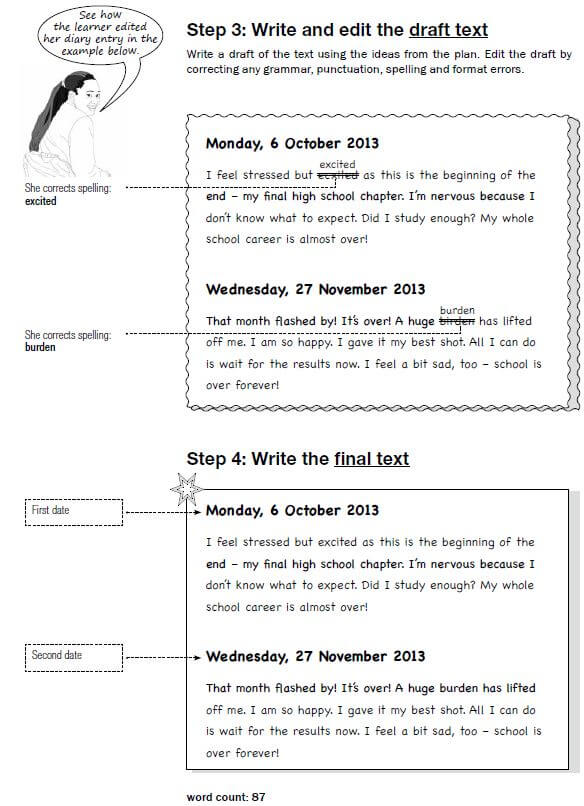
Activity: Writing a diary entry
Here are some topics to help you to practise writing diary entries:
- You have gone through a difficult period recently. You recorded your experience in a diary.
Write your diary for two of the difficult days. - Imagine that you played very well in a sports match for the school. Write a dairy entry that describes your feelings.
- You and your best friend have had an argument. Write the diary entry for two consecutive days.
3.2 Diary entry checklist
Features | Details of the feature | Yes | No | Don't know |
Text type | I understand the features of a diary entry. | |||
Topic | I understand the topic I have chosen. | |||
Content, planning and format | ||||
Planning | I can show evidence of planning. | |||
Content | Each point in plan is relevant to my topic. | |||
Purpose / Audience | I understand the purpose of a diary entry. | |||
Format | I have put a date above each diary entry. | |||
Language, style and editing | ||||
Choice of words / diction | I have chosen my words carefully to make my text interesting. | |||
Language | I have checked and corrected my grammar, spelling and punctuation. | |||
3.3 Writing a postcard
A postcard is a short message sent by post that briefly tells someone your news and lets them know you are thinking of them.
Hint:
|
Eg: A learner’s example of a postcard using the four steps
Step 1: Choose the text type and topic
This learner chose this question on a postcard:
You are far away from home at a beautiful holiday resort.
Write the text (words) of a postcard that you would send to a family member describing your experiences.
Note: Do not include illustrations.
Step 2: Plan the text
Read the question carefully. Identify the key words to use in your planning. In this topic, the key words are postcard, far away from home, beautiful holiday resort, family member and your experiences.
The learner has used a mind map to plan his postcard.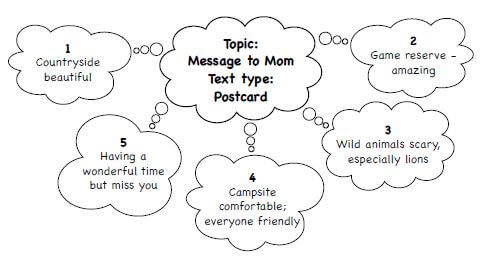
Step 3: Write and edit the draft text
Write a draft of the text using the ideas from the plan. Edit the draft by correcting any grammar, punctuation, spelling and format errors.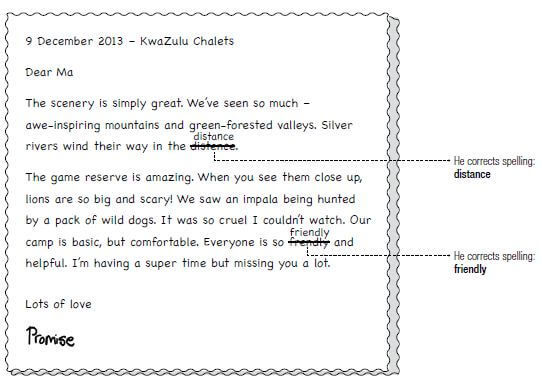

Activity: Writing a postcard
Here are some topics to help you to practise writing postcards:
- You are on holiday with school friends after completing Grade 12.
Write a postcard to your family indicating that all is well and that they need not worry about your fellow matriculants misbehaving. - You are on holiday in a resort in South Africa. At the last moment you decide to stay on longer and then travel elsewhere. Your family, however, is expecting your return.
Write a postcard to your family explaining your decision. - You have been sponsored to stay on a farm and learn another language.
Write a postcard to your sponsor telling him or her of your progress and your experiences.
3.4 Postcard checklist
Features | Details of the feature | Yes | No | Don't know |
Text type | I understand the features of a postcard. | |||
Topic | I understand the topic I have chosen. | |||
Content, planning and format | ||||
Planning | I can show evidence of planning. | |||
Content | Each point in plan is relevant to my topic. | |||
Purpose / Audience | I understand the purpose of a postcard. | |||
Format | The date and place are at the top of the postcard | |||
Language, style and editing | ||||
Choice of words / diction | I have chosen my words carefully to make my text interesting. | |||
Language | I have checked and corrected my grammar, spelling and punctuation. | |||
4. Category C
Category C in the exam paper covers the following texts:
- Instructions
- Directions
4.1 Writing instructions
The purpose of instructions is to explain how something is done.
Hint:
|
eg: A learner’s example of instructions using the four steps
Step 1: Choose the text type and topic
This learner chose this question on instructions.
You have been asked by your sports coach to help if a mouth-to-mouth emergency situation occurs on the sports field. He has asked you to write a set of instructions on mouth-to-mouth artificial respiration.
These instructions will be distributed to all athletes. Write out this set of instructions.
Step 2: Plan the text
Read the question carefully. Identify the key words to use in your planning. In this topic, the key words are emergency situation; mouth-to-mouth artificial respiration; athletes; and set of instructions.
The learner has used a list to plan her instructions.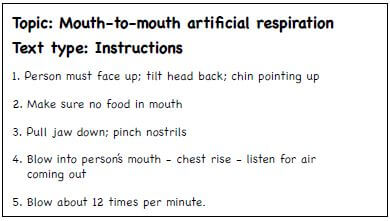
Step 3: Write and edit the draft text
Write a draft of the text using the ideas from the plan. Edit the draft by correcting any grammar, punctuation, spelling and format errors.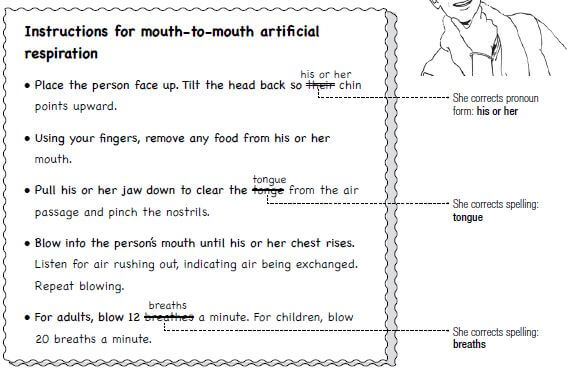
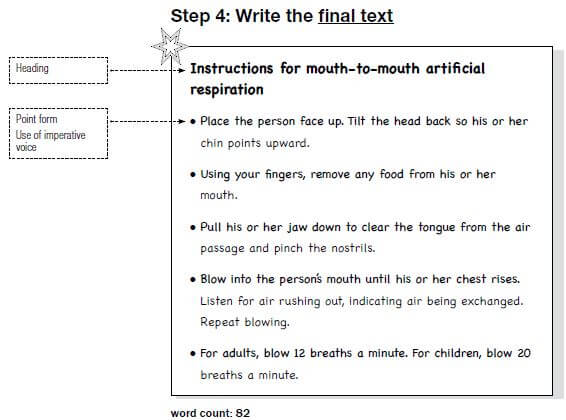
Activity: Writing instructions
Here are some topics to help you to practise writing instructions:
- You have been asked to do a short oral presentation for a Life Orientation lesson on how to lead a healthy, balanced life. Write down a list of 6–7 tips you would give your classmates in your presentation.
- Your younger brother has asked you to help him cover his school exercise books. Write out a set of instructions that will enable him to carry out this task.
- Your school wishes to start a recycling programme. Your principal has asked you, as a member of the Learners’ Representative Council, for assistance. Write out a set of instructions that will be posted on the wall of every classroom.
4.2 Instructions checklist
Features | Details of the feature | Yes | No | Don't know |
Text type | I understand the features of instructions. | |||
Topic | I understand the topic I have chosen. | |||
Content, planning and format | ||||
Planning | I can show evidence of planning. | |||
Content | Each point in plan is relevant to my topic. | |||
Purpose / Audience | I understand the purpose of instructions. | |||
Format | I have given my instructions a heading. | |||
Language, style and editing | ||||
Choice of words / diction | I have chosen my words carefully to make my text interesting. | |||
Language | I have checked and corrected my grammar, spelling and punctuation. | |||
4.3 Writing directions
Directions explain to someone how to get to a certain place.
Hint:
|
eg: A learner’s example of directions using the four steps
Step 1: Choose the text type and topic
This learner chose this question on directions:
You and your friends have decided to meet at your house to celebrate the end of the examinations. Write out the directions you will give your friends to travel from the school to your house.
Note: In your response, you must include some distances, turns and landmarks. Do not include sketches or maps.
- If you live in an urban area, include landmarks like a fast-food outlet, an intersection or a park.
- If you live in a rural area, include landmarks like a bridge, a river, or a road sign.
Step 2: Plan the text
Read the question carefully. Identify the key words to use in your planning. In this topic, the key words are your friends, directions, from the school to your house, distances, turns and landmarks.
The learner has used a list to plan his directions.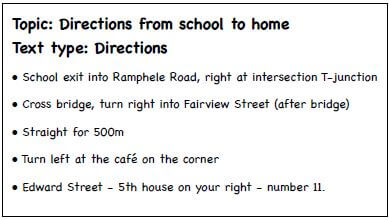
Step 3: Write and edit the draft text
Write a draft of the text using the ideas from the plan. Edit the draft by correcting any grammar, punctuation, spelling and format errors.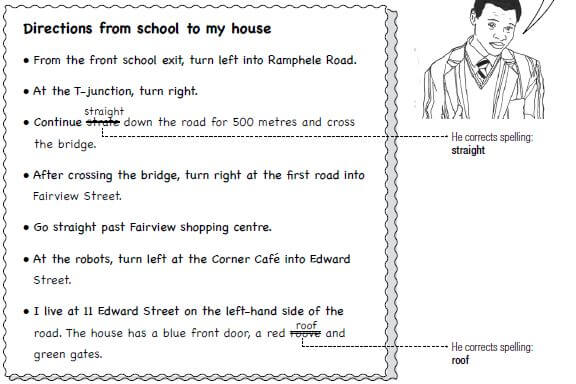
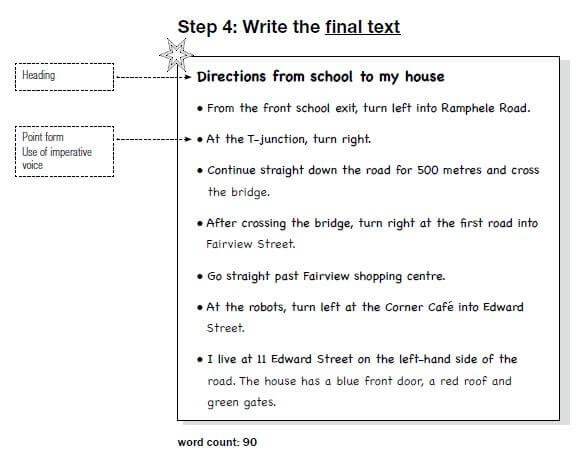
Activity: Writing directions
Here are some directions topics to help you to practise your writing skills:
- A friend from another province will be in your town and would like to visit you at your home.
Write the directions from a nearby bus stop to your house. You must include at least three turns and two landmarks (e.g. a school, a shop, a sports field) in your response.
Note: do not include illustrations or drawings. - Study the map on page 159. You are shopping at Lucky’s Supermarket (point X on the map) when a customer asks you for directions to the post office (point Y on the map).
Write out the directions you will give to the customer. In your response you must refer to the streets and landmarks on the route you choose.
4.4 Directions checklist
Features | Details of the feature | Yes | No | Don't know |
Text type | I understand the features of directions. | |||
Topic | I understand the topic I have chosen. | |||
Content, planning and format | ||||
Planning | I can show evidence of planning. | |||
Content | Each point in plan is relevant to my topic. | |||
Purpose / Audience | I understand the purpose of directions. | |||
Format | I have given my directions a heading. | |||
Language, style and editing | ||||
Choice of words / diction | I have chosen my words carefully to make my text interesting. | |||
Language | I have checked and corrected my grammar, spelling and punctuation. | |||
What is expected from you in the exam?
In the exam, you must write one shorter transactional text that is no less than 80 words long and no more than 100 words long.
The shorter transactional text question is worth 20 marks out of 100 marks in the exam. Examiners will give marks for your shorter transactional text based on:
- Content, planning and format (12 marks)
- Language, style and editing (8 marks)
The exam is 2 1/2 hours long and you should spend about 30 minutes on the shorter transactional text question.
The rubric on the next page is a table the examiners use to mark your shorter transactional text. It shows the five levels of achievement that the examiners can award a shorter transactional text, from the lowest achievement (Inadequate column) to the highest achievement (Exceptional column).
The table also describes the skills the examiner looks for when marking. For example, when marking the text, the examiner will assess how well the ideas relate to the topic, whether they are well planned, and that the format used is correct for the text type.
The rubric is a useful guide for you to use when practicing your shorter transactional text writing because it reminds you of the skills the examiner will be assessing when marking your work.
ASESSMENT RUBRIC FOR SHORTER TRANSACTIONAL TEXT – FIRST ADDITIONAL LANGUAGE [20 MARKS]
| Criteria | Exceptional | Skilful | Moderate | Elementary | Inadequate |
| CONTENT, PLANNING & FORMAT Response and ideas; Organisation of ideas for planning; Purpose, audience, features/conventions and context 12MARKS | 10-12 | 8-9 | 6-7 | 4-5 | 0-3 |
|
|
|
|
| |
| LANGUAGE, STYLE & EDITING Tone, register, style, purpose/effect, audience and context; Language use and conventions; Word choice; Punctuation and spelling 8 MARKS | 7-8 | 5-6 | 4 | 3 | 0–2 |
|
|
|
|
| |
| MARK RANGE | 17-20 | 13-15 | 10-11 | 7-8 | 0-5 |
